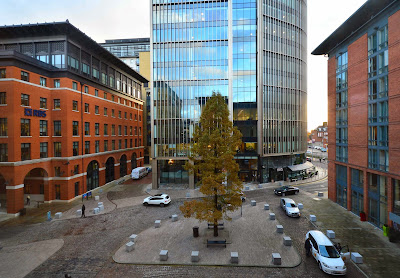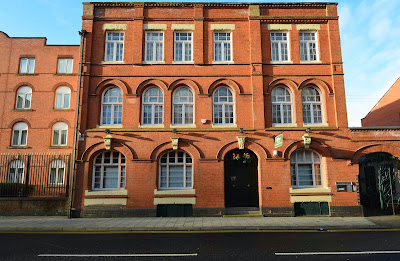Below: view from my bedroom window - Brindleyplace (one word, no space), a development begun in the early 1990s, the brickwork is contemporary but sympathetic with the city's Victorian heritage. Named after Joseph Brindley, one of the creators of Birmingham's canal network, this agreeable development of new buildings stands on what was a derelict industrial site.
Below: looking along the Birmingham Old Line Canal as it passes under Granville Street. Turn left at the end for the Gas Street Basin. The conurbation is criss-crossed with over 100 miles (160km) of navigable canals; much of the 18th Century infrastructure, wharves and warehouses, locks and bridges, is still in place and functioning, though now mainly as a tourist and leisure facility, hosting also residential narrowboats.
Below: a 1920s boozer abuts some nice brickwork; corner of Granville Street and Broad Street. The adornments on the pub roof boast the logo of Mitchells and Butlers, the Birmingham brewers that ceased brewing beer a decade ago and now manage pubs under different brands, including O'Neills,such as this one.
Below: further down Granville Street - brick arches with stone lintels on the second floor, solid, respectable Victorian architecture, scrubbed clean of grime and soot.
Below: plainer, early Victorian brick frontage with stone lintels over the windows. Note almost complete lack of decorative elements, and yet the simplicity of the design pleases the eye. This was the Hopkinson Tinplate Factory back in 1839.
Below: the same early Victorian brickwork, at ease with more modern architecture on this sunny morning. The building is now home to the Arts Council.
Below: Birmingham cobblestone. Much of what was underfoot in Birmingham would have looked like this before asphalt became ubiquitous. Slippery when wet and bumpy, it puts one in mind of clattering horse-drawn carts and bone-shaking bicycle rides.
Below: Engineering Blue - the bricks used to build the bridges, tunnels and retaining walls of Victorian Britain, built to support heavy loads for centuries. This canal bridge needs some pointing between the bricks though; the look like they might come loose in a decade or three.
Neither brick nor Victorian but still worthy of posting here; St Thomas' Church, a neoclassical edifice built after 1818 to commemorate the victory at the Battle of Waterloo. This is one of two 'Waterloo churches' in the city. St Thomas' was bombed by the Luftwaffe in 1940, leaving only the tower and entrance and rear portico. The space between has been preserved as a Peace Garden, though the tower itself is closed off from the public being in danger of collapse.
Below: into the Birmingham suburb of Edgbaston, this is the Calthorpe Park keeper's lodge on the corner of Pershore Road and Speedwell Street. It dates back to 1857, the height of the Victorian craze for neogothic ornamentation. Above the first floor window, the coat of arms of the City of Birmingham, and its motto: 'Forward'.
Birmingham has come a long way since the 1960s when ugly monstrosities like the Bull Ring Centre and New Street Station were allowed to be built. The latest wave of development boasts architecture that is generally at one with the city's heritage.
This time last year:
Welcome to Lemmingrad
This time three years ago:
Dream highway
This time four years ago:
The Days are Marching
This time six years ago:
First snow, 2007
















1 comment:
Beerming'am – England's Łódź! Similar in so many ways.
Post a Comment